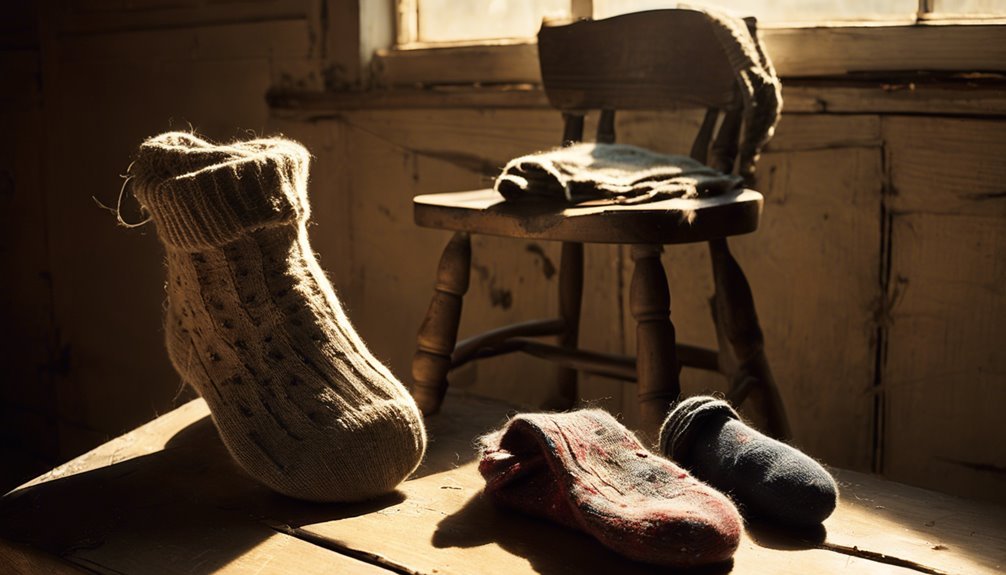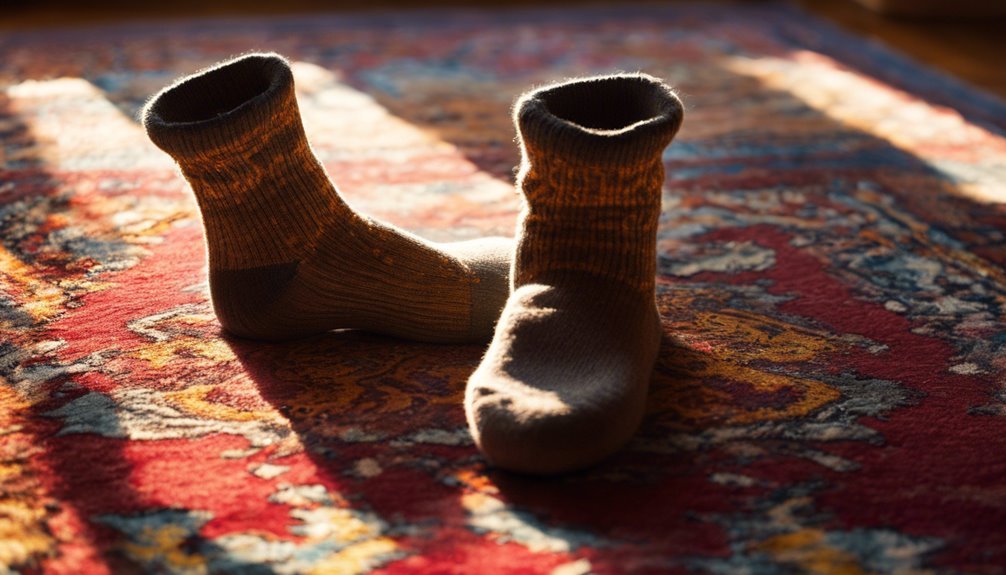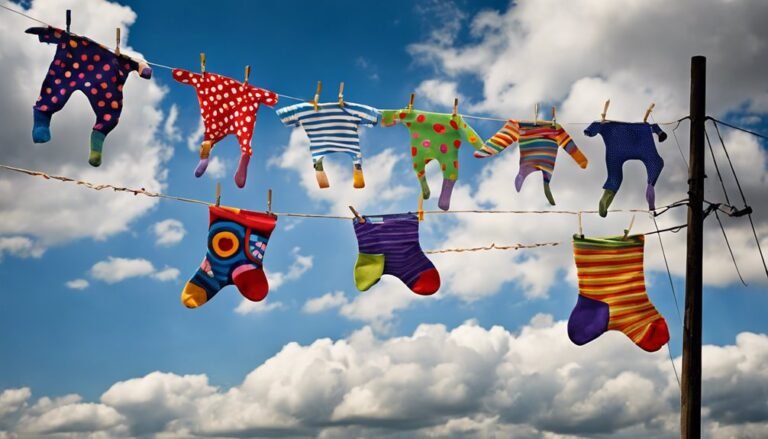Is It Bad Luck to Wear Socks With Holes?
Have you ever noticed how a small hole in your sock can suddenly feel like a portal to another dimension? While it might seem trivial, wearing socks with holes isn't universally considered bad luck.
It reflects varied cultural beliefs, from Ancient Rome's notions of misfortune linked to torn garments to Greek warriors valuing worn attire for resilience.
Modern interpretations often appreciate imperfections as authentic, with philosophies like Japan's Wabi-Sabi embracing flawed beauty.
Ultimately, the meaning you assign to holey socks can reflect personal narratives. By uncovering their deeper symbolism, you might find nuances in these old beliefs.
The Origins of Clothing Superstitions

Throughout history, clothing superstitions have woven themselves into the fabric of human culture, often reflecting the beliefs and fears of different societies. You might find it fascinating how fashion history is peppered with tales of garments bringing fortune or misfortune. As cultures evolved, so too did their interpretations of what clothing signified. In ancient Rome, wearing specific colors could invoke divine favor, while in medieval times, certain garments were believed to repel evil spirits. These beliefs highlight a cultural evolution, where clothing wasn't just for protection or modesty but also a symbol of status and fate. When you slip on a sock with a hole, you're participating in a rich tapestry of human expression where freedom from superstition might just be the ultimate fashion statement.
Cultural Perspectives on Wardrobe Luck
Imagine you're slipping on a pair of socks with holes, and you might wonder how different cultures perceive such wardrobe quirks. In ancient Rome, wearing torn garments was thought to invite misfortune, whereas in Japan, a small imperfection in clothing can symbolize humility and the acceptance of life's flaws. Across cultures, these beliefs reflect the deeper symbolism clothing holds, intertwining personal luck with the fabric of societal and historical narratives.
Superstitions Around Clothing
While clothing choices often seem mundane, they're steeped in superstitions and cultural beliefs that add layers of meaning to our daily attire. In many cultures, fashion taboos dictate what's considered unlucky or inappropriate. Socks, for instance, carry their own symbolism. In some traditions, wearing socks with holes is seen as an invitation to misfortune, perhaps because they symbolize neglect or poverty. Historically, garments have been more than just protection against the elements; they've been a canvas for expressing identity and beliefs. You might find that breaking fashion taboos feels freeing, allowing you to challenge societal norms and embrace your individuality. So, go ahead—wear those holey socks if you choose. It's your journey, and the only superstition that matters is the one you believe in.
Global Wardrobe Beliefs
The concept of luck in clothing goes beyond superstitions about socks with holes and weaves its way into global wardrobe beliefs. Across cultures, wardrobe rituals and clothing taboos shape your approach to dressing. In Japan, wearing red to a funeral is taboo, symbolizing life amidst mourning. Meanwhile, in India, donning white for weddings can be seen as unlucky, as it's traditionally worn at funerals.
| Culture | Wardrobe Ritual | Clothing Taboo |
|---|---|---|
| Japan | Red for celebrations | Red at funerals |
| India | White for purity | White at weddings |
| Scotland | Tartan for clan identity | Mixing tartans |
These beliefs reflect deeper symbolic interpretations, reminding you that freedom in fashion doesn't mean ignoring cultural contexts. Embrace the stories clothes tell.
The Symbolism of Holes in Fabric

When you think about holes in fabric, you're tapping into a rich tapestry of historical beliefs and cultural interpretations. In ancient times, such imperfections were seen as portals for spirits, suggesting vulnerability or protection depending on the era and culture. Today, they might symbolize resilience, a nod to the Japanese art of kintsugi, where flaws are embraced and celebrated rather than hidden.
Historical Beliefs on Holes
Throughout history, holes in fabric have held various symbolic meanings across different cultures. In ancient times, the historical garment significance of holes could indicate social status. For instance, the wear and tear of a garment might reflect a life of toil, yet also symbolize resilience against societal fashion norms. In medieval Europe, a hole in your clothing might have been seen as a sign of poverty, but it also suggested freedom from the constraints of wealth and materialism. Meanwhile, in some indigenous cultures, holes were deliberately made as spiritual symbols, channeling energy or allowing for spiritual connectivity. By wearing socks with holes, you might unknowingly embrace a historical rebellion against conformity, celebrating a spirit that values personal liberation over societal expectations.
Cultural Interpretations of Wear
Even as cultures shift and evolve, the symbolism of holes in fabric remains a fascinating tapestry of meanings. In some societies, these imperfections represent rebellion against societal norms, suggesting a yearning for authenticity and freedom. Historically, worn clothing might've signified poverty, yet today, it can also symbolize a carefree spirit, defying the rigid expectations of perfection.
In Japanese culture, the concept of wabi-sabi embraces the beauty of imperfection, suggesting that holes tell a story of life's journey. Meanwhile, Western punk culture famously adopted torn fabric as a statement against conformity. You see, holes in socks can be more than mere wear and tear; they're a reflection of cultural symbolism, challenging you to question what you're told about appearance and value.
Folklore and Old Wives' Tales About Socks
While it's easy to dismiss socks as mere foot coverings, the fabric of folklore and old wives' tales weaves them into a tapestry rich with cultural symbolism and historical intrigue. Across different cultures, sock rituals have emerged, each carrying its unique charm. In some traditions, wearing mismatched socks is believed to ward off evil spirits, a nod to the belief in breaking patterns to confuse malevolent forces. The fabric folklore surrounding socks often speaks of protection and prosperity, sometimes predicting future journeys or adventures based on the state of one's socks. In medieval Europe, gifting socks was a gesture of goodwill, symbolizing warmth and care. Embrace these tales as a quest for freedom, stepping into the unknown, one sock at a time.
Psychological Effects of Wearing Worn-Out Clothing

The stories and superstitions surrounding socks invite us to contemplate how our attire reflects more than just fashion or function. Consider the psychological comfort derived from your clothing identity. Throughout history, attire has signified status, rebellion, or conformity. Worn-out clothing, like socks with holes, may symbolize resistance against societal norms. Yet, it can also represent an authentic embrace of simplicity, a freedom from materialism.
In cultures valuing appearances, such attire might challenge traditional perceptions. However, choosing comfort over convention can be liberating. By wearing what resonates with you, even if tattered, you assert independence. Your identity isn't confined by pristine garments but is a tapestry woven from experiences and choices. Let your clothing reflect who you truly are, beyond societal expectations.
The Impact of Appearance on Confidence and Fortune
Though often overlooked, the way you present yourself can intricately weave into your sense of confidence and perceived fortune. In many cultures, clothing serves as a powerful symbol, echoing through history as a reflection of status and identity. Imagine a knight's armor, polished and unyielding, offering both physical protection and a confidence boost. Similarly, enhancing your appearance can fuel your inner freedom, transcending societal barriers.
When you slip on socks without holes, you're not just avoiding discomfort; you're crafting a narrative of self-respect. This simple act can shift your mindset, encouraging you to walk with a renewed sense of purpose. In doing so, you invite good fortune, as ancient belief intertwines with modern psychology, suggesting that how you feel can shape your destiny.
Scientific Insights Into Superstitions and Behavior
As you consider the impact of appearance on confidence, it's intriguing to explore how superstitions and scientific insights shape human behavior. Throughout history, people have woven superstitions into the fabric of daily life. In superstition psychology, these beliefs often influence behavior patterns, subtly guiding choices and actions. Wearing socks with holes might seem trivial, yet it can symbolize vulnerability or neglect, echoing ancient traditions where damaged clothing was believed to invite misfortune.
Understanding these patterns offers freedom from unseen chains. You see, cultural contexts lay the groundwork for these beliefs, rooted in historical fears or societal norms. By interpreting these symbols, you're empowered to break free from irrational fears. Science peels back layers of tradition, revealing how much control you truly possess over your actions.
Anecdotal Evidence and Personal Experiences
Ever wondered why some people cling to seemingly irrational habits, like wearing socks with holes? Immerse yourself in the world of sock stories, where personal anecdotes reveal a rich tapestry of cultural beliefs. Consider the symbolic warrior of ancient Greece, refusing to mend his battle-worn attire, claiming it preserved his fighting spirit.
- Cultural Symbolism: Your worn socks might symbolize resilience and authenticity.
- Family Traditions: Some share tales where grandparents swore by holey socks for prosperity.
- Rebellion Against Norms: There's a liberating thrill in defying societal expectations.
- Serendipity: A friend might swear they met their soulmate on a day their toes peeked through.
These personal experiences reflect a universal desire for autonomy, transforming simple socks into powerful symbols of freedom and identity.
Modern Interpretations of Traditional Beliefs
While modern society often prioritizes sleekness and perfection, there's a growing movement that finds value in the imperfect and worn. This shift represents a cultural rebellion against homogenized standards, embracing the beauty of flaws as a form of modern symbolism. You might see a hole in your sock not as bad luck but as a reflection of resilience and individuality, echoing historical reverence for worn objects that tell stories.
| Cultural Context | Historical Reference | Symbolic Interpretation |
|---|---|---|
| Japanese Wabi-Sabi | Mended garments in history | Imperfection as beauty |
| Minimalism's rise | Artisan crafted items | Authenticity and truth |
| Eco-consciousness | Wartime thrift practices | Sustainability values |
These cultural shifts encourage you to view imperfections as liberating, redefining luck through a personal lens.
Frequently Asked Questions
Can Wearing Socks With Holes Affect My Career Prospects?
Wearing socks with holes might not directly affect your career, but it could subtly undermine your career confidence and professional appearance. In history, attire symbolized status; today, it reflects your self-respect and freedom to choose wisely.
Are Certain Colors of Socks Luckier Than Others?
In the tapestry of cultural sock beliefs, certain hues dance with fortune's favor. Red often symbolizes prosperity in Eastern traditions, while green might echo renewal. Embrace sock color significance and step boldly into your personal expression of luck.
How Often Should I Replace Socks for Good Luck?
You're wondering about sock replacement frequency for good luck. Historically, superstitious sock habits suggest changing them with the seasons, embracing renewal. Symbolically, fresh socks can signify new beginnings, offering freedom from the past's constraints.
Do Celebrities Believe in Sock Superstitions?
Oh, the trials of celebrity fashion! You'd think they've got bigger worries than sock superstitions. Yet, like gladiators of style, they navigate beliefs that date back to ancient Rome. Freedom's found in dismissing such symbolic chains, right?
Is There a Particular Day Considered Unlucky for Wearing Holey Socks?
While no specific day is universally deemed unlucky for wearing holey socks, superstitious beliefs vary. Historically, holey socks symbolized poverty or neglect, yet today, they might simply reflect your free-spirited nature, unconstrained by societal norms.







